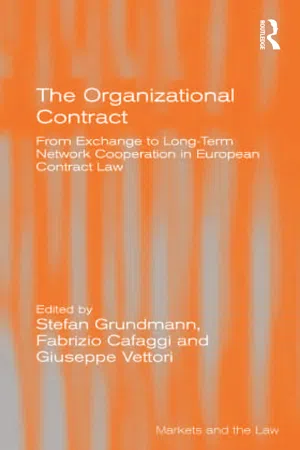4 See F. Möslein and K. Riesenhuber, ‘Contract Governance – A Draft Research Agenda’ 5 European Review of Contract Law 248–89 (2009); Grundmann, Möslein and Riesenhuber (eds), n 2 above; A. Habel, Contract Governance – eine verfassungsrechtliche und rechtsdogmatische Analyse zu vertraglichen und vertragsrechtlichen Regelungsstrukturen in Belangen des Gemeinwohls (Baden-Baden, Nomos, 2012); and in this volume below § 12 (Möslein, last n above); particularly close before, namely in the English literature, J. Brownsword, Contract Law – Themes for the 21st Century (2nd edn, Oxford: Clarendon, 2006); H. Collins, Regulating Contracts (Oxford: Oxford University Press, 1999). Three elements would seem to be the cornerstones of the architecture:
Duration: This is, first, that the backbone of the organizational contract is its long-term character, its increased stability, as opposed to its characteristic of exchange. With the peculiarities of long-term relationships, the organizational contract may even be more distinct from the exchange contract than from other areas of the law, namely organizations such as companies. The phenomenon of duration is, of course, not monolithic. Even in exchange contracts, there are simultaneous and deferred exchanges (with a time span between formation of the contract and execution), the latter already creating a problem of duration which calls for some governance responses. There are simple and complex exchanges. The phenomenon of (complex) long-term contracts in its largest sense, however, encompasses more. Typically, in long-term contracts, contrary to what is the case in simple exchange contracts (‘discrete contracts’), core objects cannot be defined in advance, not even the object of performance itself, or only very vaguely. Long-term contracts – as opposed to short-term contracts – often create the problem that even the object of performance needs to remain open, because the future vicissitudes of the relationship are ignored by the parties. A second distinction largely runs parallel, but has its own merits nevertheless. This is the distinction between discrete contracts and relational contracts, the latter being characterized by a largely increased interdependence of performances – which again implies that the degree of risk sharing is much higher than in traditional exchange contracts and that therefore each party may have additional tools beyond legal sanctions for reacting to (‘punishing’) poor performance by the other party.
Number of participants: The second cornerstone would seem to be that the organizational contract, while in principle also possible between two parties only, would mostly come with a plurality of parties, either as linked contracts or (more seldom) as a genuine multiparty contract. Therefore one traditional foundation of contract law, privity or relativity of contracts, the credo that there are effects in principle only between two parties, is questioned in relation to linked contracts among heterogeneous parties.
Finally, the relationship to company law: If really the ‘organizational contract’ forms a second pole besides the traditional exchange contract, not only are we faced with a new pole in contract law, adding a lot of heterogeneity to contract law and its foundations – from ‘exchange to cooperation’ or more precisely: cooperation supplementing exchanges and common activities as a second paradigm of contract law – but yet another comparison would seem to be needed. If organization is traditionally associated with the law of organizations and companies (so-called ‘hierarchies’) and exchange with the law of contracts, the concept of an organizational contract would certainly raise the question of its relationship with company law; it would need to be compared to core features of company law. The third ‘architectural’ question would therefore be what distinguishes the organizational contract from organization via company law, and which are the parallels? Considering cross-sections between company and (this branch of) contract law might even be a field of inquiry in its own right. 5 Along these lines two important issues need to be addressed. Is it possible and desirable to partition assets of the contracting parties so that the resources for the common project will be separated from those deployed for individual projects? Furthermore can contracts with limited liability be created similarly to the partition conventionally adopted in company law where both entities with and without limited liability coexist?
5 S. Grundmann, ‘On the Unity of Private Law – From a Formal to a Substance Based Concept of Private Law’ European Review of Private Law 1055–78 (2010); focusing rather on the interplay than on a comparison, Möslein, n 3 above, 297–319. It should be emphasized that organizational contracts are characterized by something more than pure exchanges. Parties can develop a common project (creation of a platform for logistics, creation of a new patent) with the organizational contract. Both in linked contracts and in multiparty contracts, parties often combine exchanges of information and performances with activity in common. For example in research and development contracts, parties perform activities together, but little or no exchanges take place. Slightly differently in supply chains, there are exchanges, but they are instrumental to the production of a final product. Therefore, there is not only the divide between spot contracts and long-term contracts, but – running often in parallel – also the divide between exchange contracts and contracts for cooperation, the latter often even a mix of several types of duties and contracts.
